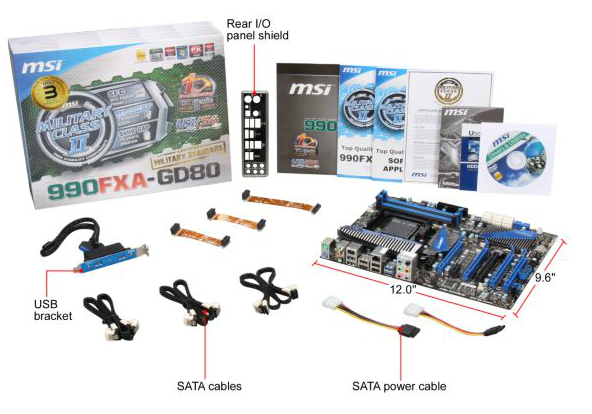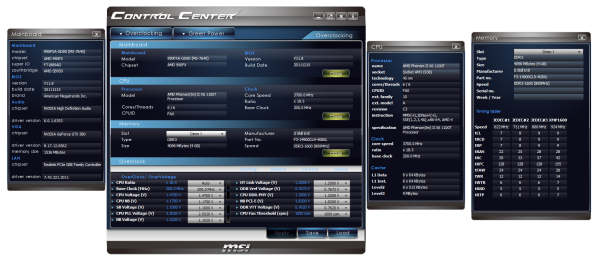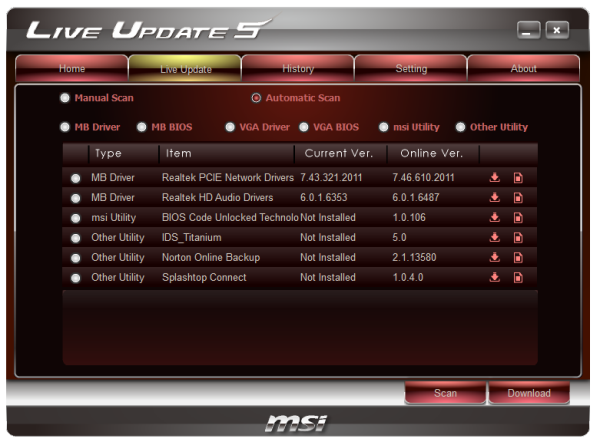990FX Motherboard Roundup with Thuban and Bulldozer – A Second Wind for ASUS, Gigabyte, MSI and Biostar
by Ian Cutress on April 5, 2012 11:00 AM ESTMSI 990FXA-GD80 In The Box
For a 990FX board, MSI has put thought and effort into what we get in the box here. For $195, it is good to see this much in the box! As the USB 3.0 port is at a right angle, the USB 3.0 bracket supplied has the option of going to the back of the case or in the front by removing the bracket. In terms of what we get:
IO Shield
Driver CD
User Guides
Three flexible SLI connectors
Six SATA cables (locking, right angled)
Two Molex to SATA power cables
USB 3.0 bracket

Image courtesy of Newegg
Board Features
| MSI 990FXA-GD80 | |
| Price | Link to Newegg |
| Size | ATX |
| CPU Interface | AM3+ |
| CPU Support | AMD FX/Phenom II/Athlon II/Sempron |
| Chipset | AMD 990FX |
| Base Clock Frequency | 200.02 MHz |
| Core Voltage | Auto, Range Dependant on CPU |
| CPU Clock Multiplier | Auto, 4x to 32.5x |
| DRAM Voltage | Auto, 1.199 V to 2.460 V |
| DRAM Command Rate | Auto, 1T or 2T |
| Memory Slots |
Four DDR3 DIMM slots supporting up to 32 GB Up to Dual Channel Support for DDR3, 800-2133 MHz, |
| Expansion Slots |
3 x PCIe Gen2 x16 (x16/x16 or x16/x8/x8) 2 x PCIe Gen2 x4 2 x PCIe Gen2 x1 1 x PCI |
| Onboard SATA/RAID | 6 x SATA 6 Gbps, Support for RAID 0, 1, 5, 10 |
| Onboard |
6 x SATA 6 Gbps (SB950) 5 x Fan Headers 1 x Front Panel Header 1 x S/PDIF Output Header 2 x USB 2.0 Headers 1 x USB 3.0 Headers 1 x IEEE1394 Header 1 x Serial Port Header 1 x Clear CMOS Header Power/Reset Buttons 1 x OC Genie Button 1 x TPM Module Header |
| Onboard LAN | Realtek 8111E |
| Onboard Audio | Realtek ALC892 |
| Power Connectors |
1 x 24-pin ATX connector 1 x 8-pin 12V connector |
| Fan Headers |
1 x CPU Fan Header 4 x SYS Fan Headers |
| IO Panel |
2 x Keyboard/Mouse PS2 Port 1 x Optical SPDIF Output 1 x Coaxial SPDIF Output 1 x Gigabit Ethernet 2 x USB 3.0 4 x USB 2.0 2 x eSATA / USB 2.0 Combo Ports 1 x Clear CMOS Button Audio Outputs |
| BIOS Version | B80 |
| Warranty Period | 3 Years |
Amazingly the MSI board is the only one which hits the 200 MHz base frequency spot on. The other boards hover at 200.7 MHz (or 201.3 MHz) due to the way the frequency is determined. As a result, you would expect the performance to be a little worse on the MSI, unfortunately. For features, there is not anything out of the ordinary here compared to the other 990FX products apart from the odd fan header arrangement. We also have another Realtek NIC/Audio combination, as well as a three year warranty.
Software
Rather than attempt an all-in-one solution for their software, MSI are using the ‘bombard’ approach, as the majority of their software features come under different installations and names. The major one is Control Center:
Control Center is the face of overclocking, voltages and the limited fan controls. With this software you can apply OC Genie, unlock cores in your processor, or turn the LEDs on the motherboard off if they bother you.
Another important element in the MSI arsenal is Live Update 5, a piece of software I rather like. Live Update 5 will analyze your system in terms of BIOS, drivers and utilities and double check with the MSI servers if you have the latest versions. If you do not, then the system will ask if you want to download the necessary files. While it sounds like a good system, there is one major drawback – it does not tell you how big the files are! It also likes to download whole packages, and waiting for a 130 MB audio driver update does not sound like fun. However, it is useful for BIOS updates.
Also available from MSI is Network Genie, an application designed to prioritize certain types of network traffic over others, and Teaming Genie, which combines network ports into single transmissions (however users will need to add network cards to use this functionality).


















57 Comments
View All Comments
IanCutress - Thursday, April 5, 2012 - link
Unfortunately we don't have an infinite amount of kit to review with. We're individual reviewers here, not all working in a big office. Obviously we can't all request top end kit from manufacturers either. Plus for every time we do use new high end kit, we also get comments about testing something 'more realistic' to most users. In that circumstance, we can't win and please everyone, but we do try and be as consistent as possible.Ian
phocean - Thursday, April 5, 2012 - link
I bought the Sabertooth a few weeks ago... and it throws an annoying buzzing sound in the speakers, especially when a USB port is used (in other words, all the time).It is the sign of an isolation issue between chipsets and shows poor design and testing from Asus.
Needless to say that the support was of no help (and no willing to help).
So don't buy it, unless you don't plug any speaker in it.
richaron - Friday, April 6, 2012 - link
Mine doesn't have this problem. You either got an unlucky board, or your psu is funky.extide - Thursday, April 5, 2012 - link
Seem to me like you were probably using a bit too much voltage for the BD. I would assume that is why you had so many issues with thermal runaway. 1.4-1.45ish would probably be a better place to stay with an air cooler :)extide - Thursday, April 5, 2012 - link
EDIT: Nevermind I forgot you are using the AMD kit watercooler, which is better than straight air cooling but I'd think it would take more of a fully custom built water setup to run 1.5v vCore.Hrel - Thursday, April 5, 2012 - link
I was going to build a new computer based on Ivy Bridge this Fall, I'm still running a Core 2 Duo E8400. But I've decided I'm not building myself a new computer until the motherboard has USB 3.0 and ONLY USB 3.0. A LOT of them, EVERYWHERE!I just built a guy a Z68 based computer with an i7 2700K but I had to order a VERY hard to find adapter card to plug in the USB 3.0 based memory card reader and the USB 3.0 on the front of the Fractal Design case. Because the Asus motherboard has ZERO USB 3.0 headers on it. It never even occurred to me that was a possibility. Not only has USB 3.0 been out for years now, but it was released WAY over-due. WTF is the hold up. Make the switch. USB 2.0 is for the 2000's decade, it's 2012. I am done with USB 2.0. I shouldn't have to buy an add-in card for BRAND NEW motherboard to support basic accesories, like a memory card reader and front usb port.
This is related to this article because I think if AMD was actually competitive with Intel AT ALL, like they were with Athlon XP/64/64 X2, then Intel would step up their game all around. Or maybe I wouldn't even have to buy Intel because they constantly make shit decisions like this, and changing the motherboard socket constantly, and charging 300 dollars for a quad core with HT. Their shit is endless and I really don't want to buy their products but AMD is simply not an option; if I wanted something that slow I'd just put a quad core Penryn based CPU in my current rig and save a bunch of money.
ggathagan - Friday, April 6, 2012 - link
There are only two Asus Z68 boards that don't have the USB 3 header, but somehow it's *Intel's* fault that Asus didn't use a USB 3 header on the board you bought?Huh...
Maybe you should have been a little more attentive when board shopping.
IanCutress - Friday, April 6, 2012 - link
Hi Hrel,I actually like USB 2.0 on my boards. If you have solely USB 3.0 and use them all, there's a big chance of a bottleneck in the bus somewhere. Also, I install a fresh operating system on every board I test via USB as it is a lot quicker than CD. Unfortunately during the install program, it doesn't process anything through the USB 3.0 ports - mouse, keyboard, or even the USB stick with the OS on. So I ideally like to have three USB 2.0 ports for that purpose. It's more a fault of Windows7 than the chipset, but otherwise if a board only has two USB 2.0 ports, I have to disconnect the mouse and use the keyboard and USB install drive only. Saying that, I have a board in that is solely USB 3.0, so it's going to be fun to install an OS on that... :/
Ian
fic2 - Friday, April 6, 2012 - link
I have a Dell keyboard that has 2 USB ports on it. That would solve your problem with a 2 x USB 2 mb. I currently have the mouse daisy chained off the keyboard.B - Thursday, April 5, 2012 - link
Your article should note that sound blaster provides a software overlay, but under that aluminum skin overlay lies a Realtek chip. I was fooled by this marketing and very disappointed after configuring this motherboard and discovering this fact. You don't get soudblasters hardware acceleration or the crystalizer. You should note this in any article about the asus line with x-fi2. Had I known I would have done things differently.